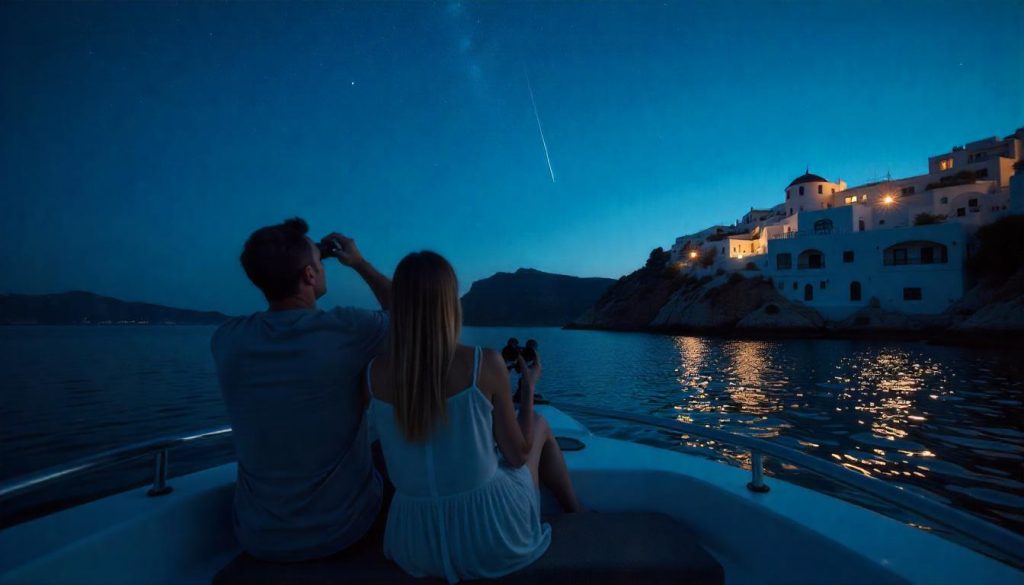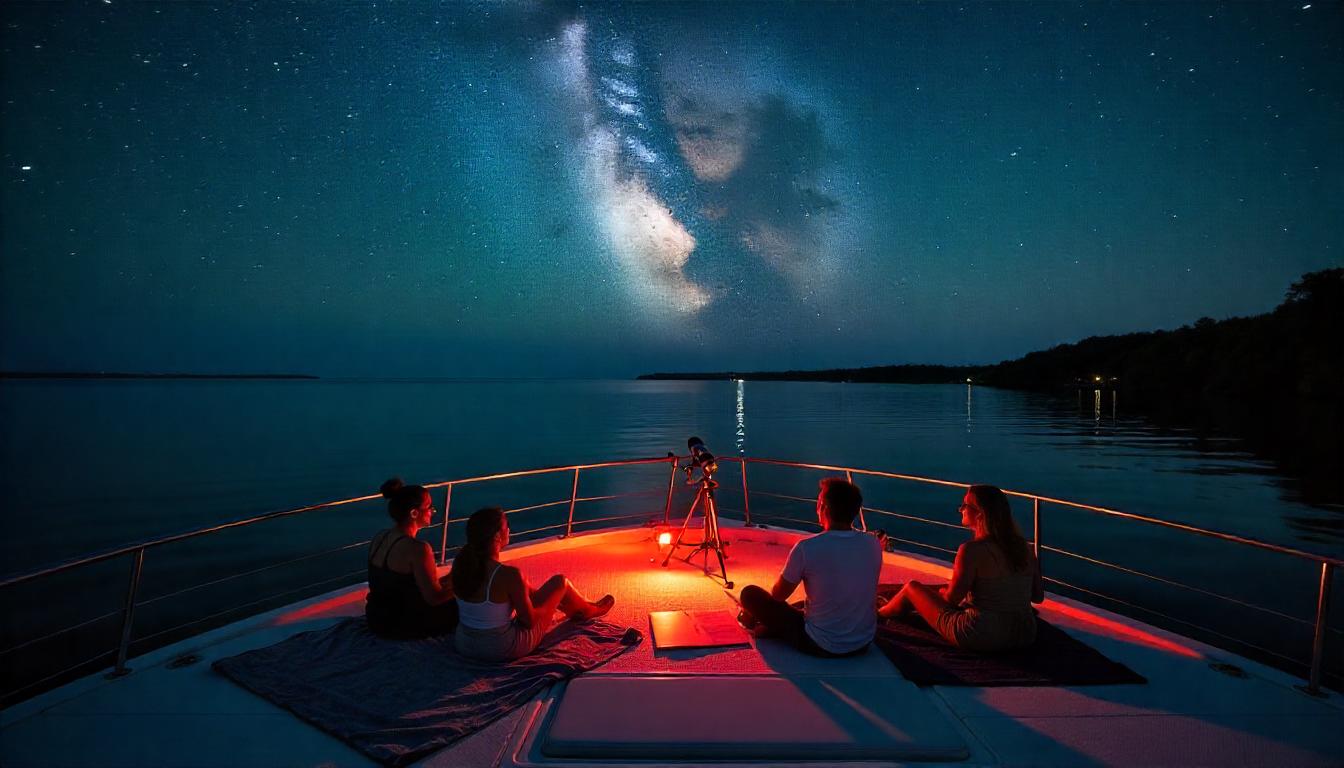A stargazing trip by boat in 2025 offers a magical way to connect with the night sky, far from city lights and surrounded by the gentle rhythm of the water. Imagine drifting under a canopy of stars, spotting constellations, and perhaps even catching a meteor shower, all from the deck of a boat. This guide will help you plan an unforgettable stargazing boat journey, covering destinations, equipment, safety, and tips to enhance your celestial experience.
Choosing the Perfect Destination
The location of your stargazing trip by boat significantly impacts the quality of your experience. Opt for areas with minimal light pollution, such as remote coastal regions or offshore waters. For instance, the Florida Keys in the U.S. offer dark skies and calm waters, ideal for stargazing. Alternatively, the Greek Islands, like Santorini or Rhodes, provide stunning views of the Milky Way against a Mediterranean backdrop.
Consider the time of year as well. Summer months, such as July and August, coincide with meteor showers like the Perseids, enhancing your trip. Moreover, check for clear weather forecasts to ensure unobstructed views. Selecting a destination with optimal conditions sets the stage for a memorable night under the stars.
Selecting the Right Boat
Your boat choice affects both comfort and visibility. A stable vessel, such as a catamaran or a motor yacht, minimizes rocking, making it easier to use telescopes or simply gaze upward. For example, a 40-foot catamaran offers ample deck space for a small group to spread out and stargaze. Additionally, ensure the boat has a flat or open deck area with minimal obstructions, like tall masts, that might block your view of the sky.
Look for boats with low-light or red-light options to preserve night vision. Furthermore, confirm the boat has enough cabin space for overnight stays, as stargazing often extends into the early hours. A well-chosen boat ensures a comfortable and immersive stargazing experience.
Gathering Essential Stargazing Equipment
The right equipment enhances your stargazing on a boat. A quality telescope, such as a Celestron NexStar, allows you to observe planets and distant galaxies. However, binoculars are a more portable option for beginners, offering a wide field of view to spot constellations. Additionally, bring a star chart or a stargazing app, like SkySafari, to identify celestial objects.
Pack a red flashlight to navigate without disrupting night vision, and consider a reclining chair or blanket for comfort while gazing upward. Moreover, a camera with a tripod can capture long-exposure shots of the night sky. Proper equipment ensures you make the most of your celestial observations.
Timing Your Trip for Optimal Viewing
Timing is critical for a successful stargazing trip by boat. Plan your trip around the lunar calendar—new moon phases offer the darkest skies, ideal for spotting faint stars. For instance, the new moon in August 2025 aligns with the Perseid meteor shower, promising a spectacular show. Additionally, aim to stargaze between midnight and dawn, when the sky is darkest and constellations are most visible.
Check the weather forecast for clear skies, as clouds can obscure your view. Furthermore, avoid areas with heavy boat traffic, as their lights can interfere with your experience. Timing your trip strategically maximizes your chances of a breathtaking stargazing session.
Ensuring Safety on the Water
Safety is paramount during a night sky boat trip. Ensure the boat is equipped with life jackets, a first-aid kit, and navigation lights to comply with maritime regulations. For example, brief your group on safety protocols, such as staying seated while the boat moves, to prevent falls in the dark. Additionally, have a captain or crew member experienced in night navigation to handle the vessel.
Anchor in a calm, sheltered area to minimize drift, and keep a VHF radio handy for emergencies. Moreover, pack warm clothing, as temperatures can drop at night, even in summer. Prioritizing safety allows everyone to relax and enjoy the stars without worry.
Planning Activities to Enhance the Experience
A stargazing trip by boat can include activities to make the night even more memorable. Start with a guided constellation tour, pointing out major stars like Sirius or the Big Dipper. For instance, use a laser pointer to trace patterns in the sky, making it interactive for your group. Additionally, share stories or myths about constellations, such as the tale of Orion, to add a cultural element.
Consider a photography session, teaching participants how to capture the Milky Way with long exposures. Furthermore, play ambient music softly in the background to create a serene atmosphere. These activities deepen the connection to the night sky and make the trip engaging for all.

편안함과 편리함을 위한 포장
Comfort is key during a stargazing boat journey. Pack snacks and drinks, like hot cocoa or light sandwiches, to enjoy while stargazing. For example, a thermos of warm tea can keep you cozy on chilly nights. Additionally, bring pillows and blankets to create a comfortable viewing area on deck.
Include bug spray for areas like the Florida Keys, where mosquitoes might be an issue, and pack extra layers of clothing for warmth. Moreover, ensure you have a waterproof bag to protect electronics from potential splashes. Thoughtful packing enhances the overall experience, keeping everyone comfortable and focused on the stars.
Navigating Light Pollution Challenges
Light pollution is a common challenge for stargazing on a boat. Sail at least 10-15 miles offshore to escape the glow of coastal cities. For instance, in the Bahamas, heading toward the Exumas ensures darker skies compared to staying near Nassau. Additionally, avoid nights with a full moon, as its brightness can wash out fainter stars.
Onboard, use minimal lighting—red lights are best, as they don’t interfere with night vision. Furthermore, ask nearby boats to dim their lights if possible, creating a darker environment for everyone. Managing light pollution ensures you can fully appreciate the brilliance of the night sky.
Choosing the Best Time of Year
The time of year affects both the weather and celestial events. Summer offers warm nights and meteor showers, like the Perseids in August, making it a popular choice. However, winter months, such as December in the Northern Hemisphere, provide longer nights and clearer views of constellations like Orion. For example, the Geminid meteor shower in December 2025 is a great opportunity for stargazing.
Check for regional weather patterns—avoid rainy seasons in tropical areas like the Caribbean. Moreover, consider your destination’s seasonal attractions, such as bioluminescent bays in Puerto Rico, which pair beautifully with stargazing. Timing your trip with celestial and weather considerations enhances the experience.
Documenting Your Stargazing Adventure
Capturing your stargazing trip by boat creates lasting memories. Use a DSLR camera with a tripod to take long-exposure shots of the night sky, capturing star trails or the Milky Way. For instance, a 30-second exposure at ISO 1600 can reveal stunning details. Additionally, take candid photos of your group enjoying the experience, such as pointing out constellations or sipping hot cocoa on deck.
Create a time-lapse video of the night sky to showcase the movement of stars over time. Furthermore, keep a journal to note the constellations you spot or any special moments, like a shooting star. Documenting the trip preserves the magic for years to come.
Conclusion: A Night Under the Stars
Planning a stargazing trip by boat in 2025 offers a unique opportunity to marvel at the universe from the tranquility of the water. From choosing the right destination and boat to timing your trip for optimal viewing, each step ensures a magical experience. Whether you’re in the Florida Keys or the Greek Islands, a well-planned stargazing boat journey promises breathtaking views and unforgettable memories. Set sail, look up, and let the stars guide your adventure.

 보트로 별 관측 여행을 계획하는 방법">
보트로 별 관측 여행을 계획하는 방법">
